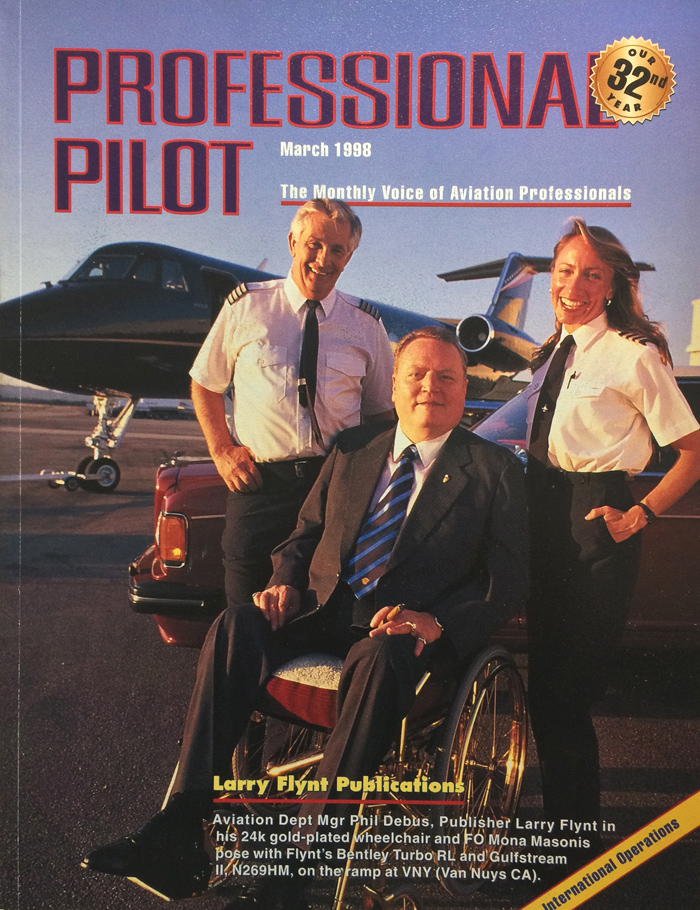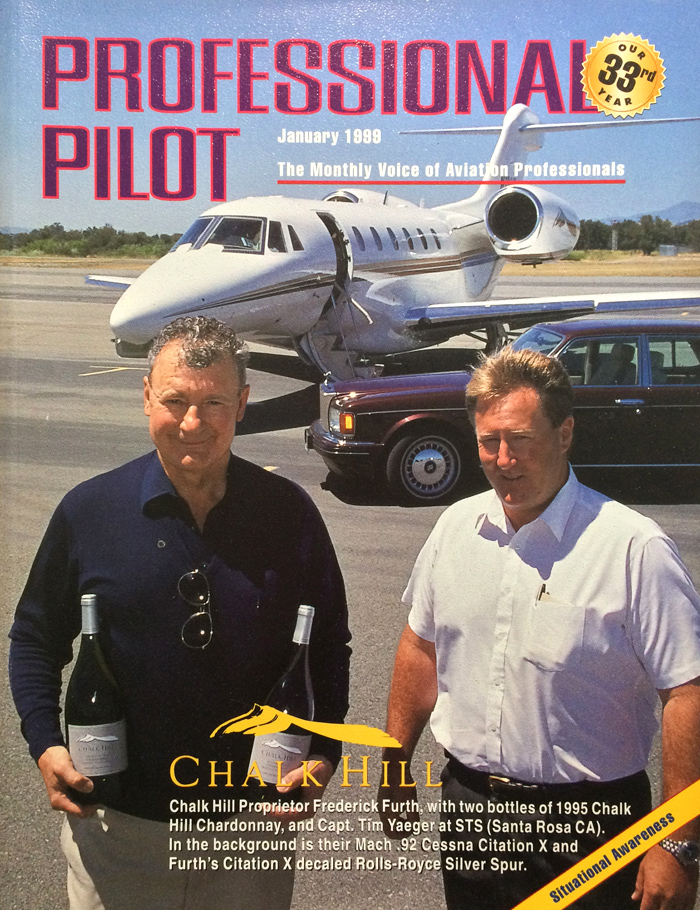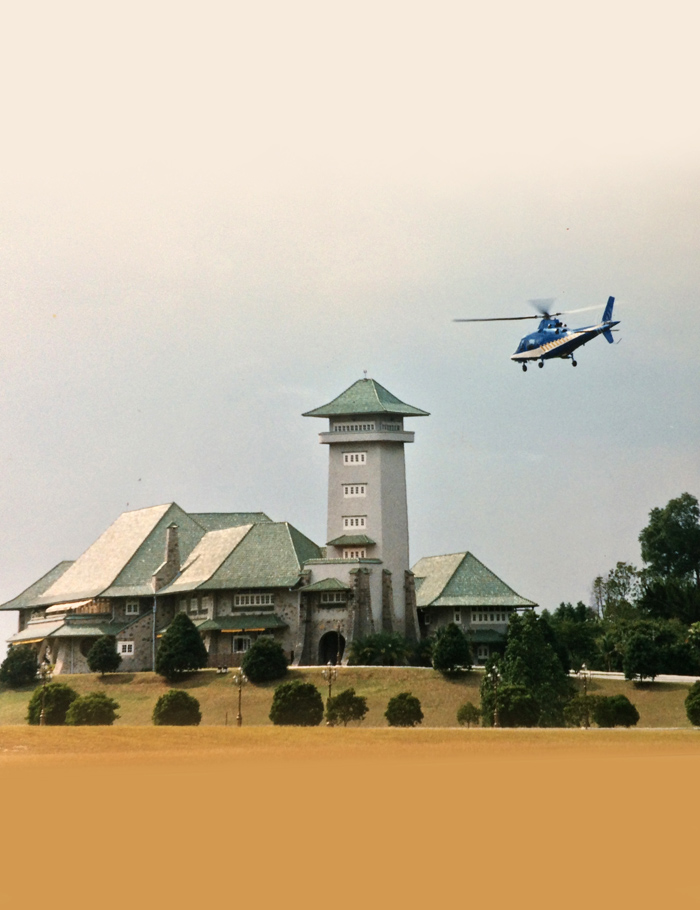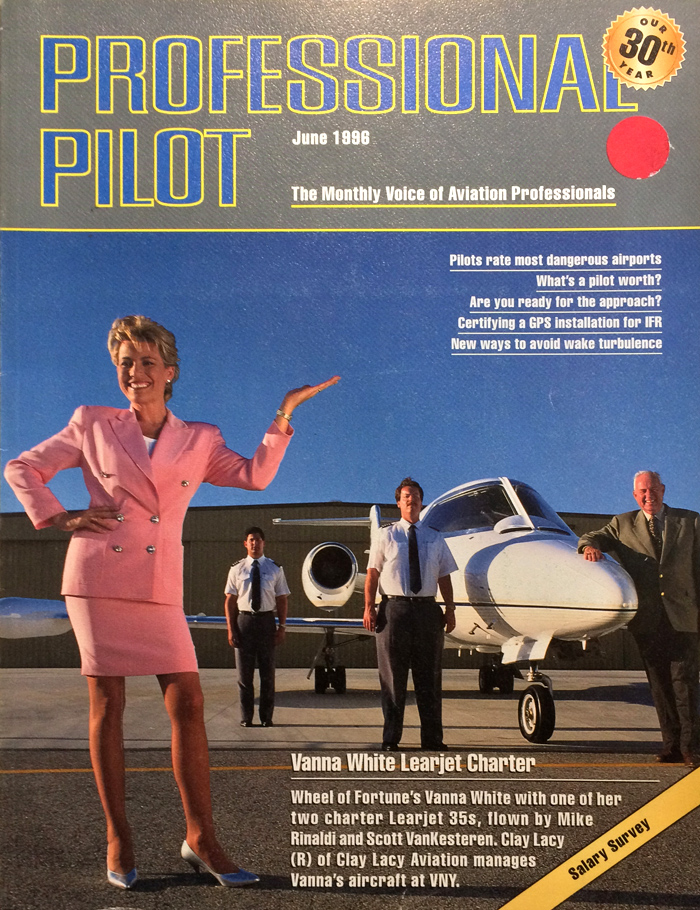Arthur Jones and the Nautilus 707s
By Grant McLaren
Professional Pilot Magazine November 1984
Doctor No would feel right at home. A private runway with so much concrete the two 707s and Cessna Citation parked at the end seem dwarfed. The mansion sprawling beside the jetport is reached by passing through a tunnel wherein resides Micky, a 340-lb gorilla. The home, reception buildings and white fencing are all reminiscent of an elegant Kentucky estate. But along with pastures full of thoroughbreds, on this 500-acre spread, one also encounters herds of elephants, lumbering rhinoceroses and voracious crocodiles.

Nautilus principals Arthur Jones (left), Terri Jones (center) and Dan Baldwin feed a few of the elephants at the Nautilus headquarters/ranch. Backdrop by Boeing.
It’s an improbably place full of the fantastic. But, unlike Dr. No’s, this place is real. Thankfully also unlike James Bond’s adversary, Arthur Jones is not trying to take over the world. At least not yet. For the time being his desires are less grandiose but far more sensual — he wants “faster airplanes, younger women and bigger crocodiles.” And one other thing: Arthur Jones wants to make a lot of money. He believes the crocs, the Boeings and Micky will help him do just that.
Laugh you may, buy Jones has already parlayed equally farfetched schemes into millions of dollars. After all, rhinos are not had for nothing.
It was Arthur Jones who in 1969 developed a cam gear shaped like a spiral-shelled nautilus mollusk. This he installed in a variable resistance exercise unit which gained rapid popularity with body builders worldwide.
The Nautilus machine truly revolutionized the world of pump and muscle. It became “the thinking man’s barbell” for good reason. The machine can give better results in 90-minutes of well-targeted exercise per week than would be possible from 20 hrs of conventional weightlifting.
Jones gives this analogy: “It takes only one properly placed shot to kill an elephant. Additional shots will serve no purpose except unnecessary destruction of the meat.”
Developed in a garage on a shoestring budget, Nautilus equipment now sells for an average of $2640 per unit. And it does so quickly, thanks to the growing public sensitivity about physical fitness. Some 4700 Nautilus Fitness Centers have opened in the US alone, with a total equipment investment of approximately $200 million. Nautilus Sports & Medical Industries now has manufacturing facilities in Independence VA and Mexia TX where some 900 employees labor.
Head office for the company, which Jones controls, is in Lake Helen FL, just south of Daytona Beach.
During the week Jones works at Lake Helen and resides nearby on a small piece of property that includes a one-bedroom house, two lakes and several dozen alligators. On the weekends he sojourns at Jumbolair, his ranch/zoo/airport in Ocala.
Jungle Jones
Arthur Jones, approximately 61, grew up in Arkansas and left school after ninth grade. Much of his life has been lived as an expatriate in the Far East and in Africa. An insular and iconoclastic man, he’s always been self-employed in peculiar pursuits — animal collector, film producer, inventor and aviator.

Jumbolair’s ramp features a giant blast/noise/privacy wall and, in this case, 2 Boeing 707s and a Cessna Citation. Walking through the rear wall portal brings you to Jumbolair’s reception area and all 340 lbs of Jones’s pet gorilla Micky.
He produced and directed the 1960s syndicated television series “Wild Cargo” which involved the capture and transport of wild animals. He has designed advanced cinamascope lenses and various airborne camera platforms. His last television film, “Operation Elephant” aired on CBS in 1970.
Although he does not elaborate on his many years spend on the Dark Continent, Jones says he has adapted the “speak softly” philosophy of Teddy Roosevelt to his own lifestyle. “Sneak around quietly and carry a Thompson submachine gun.”
Jones has lived in Florida since his return to the US in 1968; the following year he began the Nautilus phenomenon.
The fitness empire has branched out into new areas. Exercise equipment is now being designed and sold for home and school use and for physical rehabilitation. The Lake Helen headquarters also houses a complete film production and videodisc recording studio, which are managed by Terri Jones, Arthur’s striking 22-yr-old wife. Over 40 films, most of them on medical subjects, have been produced to date.
Flight life
A pilot for more than 40 yrs, Jones claims in excess of 30,000 flight hours logged in everything from a J3 Cub to a B25 to a Constellation to a Bell 47. He currently flies a Citation 2SP, registered N666AJ (the triple 6 is “the mark of the Devil,” Jones explains) and intends to get a 707 type rating soon.

Jones says zebras, giraffes and hippos will soon be joining Jumbolair’s many elephants, alligators and crocs.
His first aircraft were a pair of single engine HT13s he found in Africa in the 1940s and for which he paid less than $200. They were the first in a long series of stiff winged flying machines. Then in 1967 Jones took delivery of his first helicopter, a Bell 47 G4A; he logged 1100 hrs in the machine in Africa.
The Nautilus corporate flight department began with a Fokker F27 in 1974 and moved into a Citation 2 yrs later. The current flying stable is hefty and diverse; it includes three Boeing 707-323Cs, a Citation 2, a Beech Baron 58P and a Cessna 180.
A year after the 500-acre spread near Ocala was purchased in 1980, heavy earth-moving and paving equipment rolled in to lay down a runway 7400 ft long and an average of 360 ft wide. neighbors were understandably surprised to learn that the world’s largest (in paved area) nonmilitary runway was being constructed next door. And they hollered when the 707s, purchased from American Airlines in 1983, started arriving. But there was little they could do to stifle any of this since the county has no zoning regulations that address such matters and no operating curfews are in effect.
Once the runway was down Jones erected a concrete buffer wall 18 ft high and 58 ft thick around the 600-ft wide parking area. “We are trying to avoid incineration of people and cars on the public road immediately behind,” Jones explains.
Landing lights are to be installed, but no ILS is planned because extensive tree cutting would be required.
The 707s all have low time Pratt & Whitney JT3D-3B 18,000-lb thrust fan engines. Outfitting was done by Associated Air Center in Dallas. Dual Global VLF/Omegas are standard in the fleet.
At .83 Mach cruise, the 240,000-lb Boeings burn 2000 gph, giving them better than 14 hrs endurance. “That gets us anywhere in Africa or South America and to much of the South Pacific nonstop,” says Jones.
Missions vary widely for the eclectic fleet. The Citation 2SP is used for domestic corporate transport and is fitted with a Global VLR/Omega and Bendix color radar. It was chosen for its range, speed and short field capabilities and because of its unique single pilot option. Although transcontinental trips to visit dealers are made every month, most of the Citation flights terminate at the plants in Texas and Virginia. Runways there are 3600 ft and 4200 ft respectively. One of the Nautilus Boeings is out on a long terms cargo contract. The other two are used for intercontinental transport of animals and, in the near future, of people.
Curious cargo
Cabin volume is an important item for Nautilus. For example last July one of the 707s flew to Barbados where it fueled up; then it continued nonstop 6079 nm to Wankie Nat Park in eastern Zimbabwe. There 63 baby elephants were shepherded aboard. The petite pachyderms trumpeted all the way back to the Jones spread in Florida.
Both flights were copiloted by Terri Jones.
Arthur Jones met Terri, a Tampa native, when she was 15. She began working for the company 2 yrs later and in 1981 she and Arthur married. Previously married, Jones has four children and two grandchildren. So at 22 Terri proudly calls herself a “step grandmother.”
Like her husband, Terri is intrigued with flying and has pursued it avidly. She got her initial flight training 5 yrs ago in a Ford Trimotor and now has accumulated 1500 hrs, most of it logged in the Citation. Her right seat time in the Boeings is really preparation; in January she intends to knock 5-6 hrs off Brooke Knapp’s round-the-world speed record for unlimited class airplanes.
Meaningful menagerie
Jumbolair is a celebration of bigness — the aircraft, the animals, the earth-moving equipment, the facilities he very audacity of it all.
It is obvious Jones is comfortable around his peculiar pets. There is M’Kulu. a 925-lb croc Jones caught in 1957 and feeds by hand. Nearby is Shanka, a 6000-lb rhino named after the chief who founded the Zulu nation. Willie will work his way out of the 90-elephant herd to come to his master when called. And of course there’s Micky, the 18-month-old gorilla with 13-inch wrists who was caught in Africa when still a mere babe.
What are all these creatures doing here? Part of the reason might be a touch of homesickness. Jones spend a good deal of his life in Rhodesia and this part of Florida is reminiscent of that former nation. The old Tarzan movies were even filmed nearby.
But there is a more practical side, a promotional aspect to it. “Advertising takes many forms,” Jones observes. “He’s right, of course, as publication of this story illustrates.”
Finally Jones is an ardent student of genetics, natural selection and the evolutionary process. The concepts are easier to perceive and appreciate in the wild animal world, and understanding them helps man to better know his own role.
“Equality is a myth,” observes Jones. “Man’s genetics differ enormously.” He goes on to note that man’s form as determined by function and environment is that of a predator: “Otherwise our eyes would be on the sides of our head like a deer.”
Survival of the fittest and adaptive change has been the natural process throughout time, he says. By suppressing his predatory animal instincts, man is putting himself out of sync with evolution and the process of natural selection necessary to the health of the human species, Jones says. This, he speculates, may all surface in a world-scale upheaval instigated by nuclear war or mass famine.
Always a practical observer, Jones takes lessons from the less sophisticated predators. “The only ways to control people and advance are by terror and appealing to greed. Of the two,” he states, “terror is the more effective.”
The crocodiles are, in sense, his mentors.
Schemes, dreams, con’d
Jones plans to buy a Boeing 747 and to construct a taxi-through hangar at Jumbolair. Of the aircraft edifice he says with unabashed hyperbole, “it will be the single most impressive building in the world, beyond the Taj Mahal.”
As he envisions it the 747 will taxi over a narrow bridge that spans a lake surrounded by hippos, crocodiles, rhinos and elephants. The second floor of the hangar will glisten with 58,000 sq ft of glass overlooking the 747 below.
Terri Jones says future zoological acquisitions include zebras and giraffes. Meanwhile her husband is contemplating the possibility of adding a mammoth to the farm. That’s right, a mammoth. All fur, hair, teeth and tusks. about 30,000 lbs on the hoof. And supposedly extinct for eons.
Jones notes that some of the prehistoric elephants were frozen in Neanderthal times so quickly that their flesh was well preserved. In fact in the 1930s the New York Explorers Club went so far as to serve mammoth steaks to members. Three years ago Siberian mammoth eggs were twice thawed and successfully fertilized and gestated by Asiatic elephants.
So why not a pet mammoth? At this point nothing is likely to surprise Jones’s next-door neighbors.
Jones’s planning carries well beyond making money and machines. It goes to the ultimate. Here too the 707s come into play. Should his prediction of nuclear holocaust or world famine occur, he plans to blast off from the ranch with Terri, fly to the a Galapagos Island retreat and remain there indefinitely. One can’t help but think that Arthur Jones, the indomitable sexagenarian, would be most at home in Darwin’s paradise of adaptive survival.





